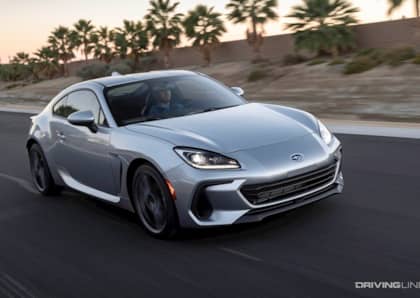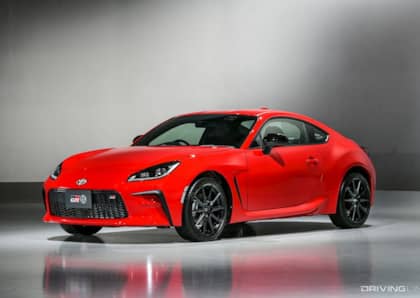Review: The 2022 Toyota GR 86 Brings More Power To The Affordable Sports Car Battle
Since it arrived just over a decade ago, the biggest knock against Toyota's most affordable sports car—the 86 (born as the Scion FR-S)—has been its perceived lack of horsepower. Few of those complaints were made by anyone who drove the fantastically balanced compact coupe, which relied on its lightweight design to make up for the modest four-cylinder engine under its hood. Rather, the slights were sourced from a general public who understandably judged it against the backdrop of ballooning horsepower available from similarly-priced Detroit muscle as well as the existing crop of import sports cars from Hyundai (the Genesis Coupe) and Nissan (the 370Z).

For 2022, the 86 has been gifted with additional grunt as part and parcel of a redesign that sees the letters 'GR' (for Toyota's in-house Gazoo Racing division) added to its name. The new Toyota GR 86 might be beefier than ever before, but that extra power doesn't dramatically transform its driving experience. Instead, it extends what was already a compelling mission, keeping the GR 86 firmly in the conversation when looking for an inexpensive alternative to the current crop of pricy high performance metal.
More Power, But Not Most Power
It's important to quantify the 2022 Toyota GR 86's additional engine output in context. Calls for a turbocharged engine capable of keeping up with eight-cylinder coupes such as the Ford Mustang GT have long been aimed in the Toyota's direction, and given that the vehicle is built on the same platform as the near-identical Subaru BRZ, many enthusiasts clamored for an STI-branded version would allow for the 86 to borrow some forced-induction fun.

There are two key factors keeping the GR 86 from transforming into a turbocharged monster. The first is cost: With a starting price of $27,700, Toyota's two-door checks in at $10,000 less than a Mustang V8. Adding heavy-breathing hardware to the car's four-cylinder engine would definitely push its cost past the point where it could still reasonably claim to be an entry-level enthusiast option.

Then there's internal politics to consider. With the GR Supra now in the stable, transforming the GR 86 into a Mustang hunter would also put it within spitting distance of Toyota's flagship sports car in terms of speed, and inevitably steal sales from the more luxurious grand tourer.
Punch (It) Out
As a result, Toyota's engineers elected to punch out the GR 86's engine from 2.0L to 2.4L, giving it a total output of 228 hp and 184 lb-ft of torque. These are hardly earth-shaking numbers, but they represent a healthy boost over the 205/153 rating offered by the original model.

More importantly, a revised powerband eliminates the troublesome torque dip that the FR-S/86 experienced with its earlier engine, a blip that interrupted both conservative daily driving as well as spirited redline runs. With a steadier application of torque (arriving at a much-lower 3,700 rpm), it's easier to stir up the sauce with the Toyota's standard six-speed manual gearbox.

The stronger engine has had an effect on the GR 86's straight-line performance. From a stop, 60 mph arrives in 5.4 seconds, which is considerably quicker than the 6.2 seconds it posted pre-redesign. Out on the road, it's harder to detect the quickness, as the engine's overall smoothness makes a stronger impression. The extra power doesn't so much inform the GR 86's character as it firms up the foundation of what is a truly excellent platform.
Changed For The Better
The details of the 2022 Toyota GR 86's chassis haven't actually changed all that much. Stiffer than before, but featuring the same basic suspension geometry, the 86 gains revised shocks and a beefier rear stabilizer bar, and while it's gained just a little weight compared to the model it replaces, with an aluminum hood, roof, and front fenders it still keeps its mass right around the 2,800 pounds mark. To find a lighter sports car under $50,000, you'll have to head to a Mazda showroom and drive home in the MX-5 Miata roadster.

Zip up to the Toyota's 7,000 rpm cut-off, dive into an approaching corner, and the GR 86 connects with the asphalt in smile-inducing fashion. Unlike many of its pricier peers that seek to overpower the road, the GR 86 invites a more collaborative approach to maintaining momentum, its Torsen limited-slip differential canceling out any wheel spin that might be induced by its modest engine output.

Driving the coupe flat-out won't catapult you into the danger zone in the same way a Camaro SS or Mustang GT might, but it's hard to say that it's any less fun, especially on a track where pilots don't have to worry about wildlife or the local constabulary.
A Balanced Bargain
There are of course downsides to Toyota's budget-friendly approach to the GR 86. At cruising speeds the cabin is loud and rowdy to the point where I struggled to hear the vehicle's stereo system.

Its infotainment setup, while improved, is also a little laggy, and its rear seats might as well be labeled a cargo shelf, as you're more likely to fold them down to transport tires to your local track day than you are to pretzel your friends into their torturous contours.

These trade-offs are all to be expected in a vehicle that prizes the drive over nearly anything else. Marginally larger than the model it replaces, the GR 86 is still the smallest and lightest rear-wheel drive, two-door hardtop available for those who would rather invest in sticky rubber and suspension upgrades than lay a smoky patch at the drag strip. In a world that's increasingly focused on horsepower and tech above all else, Toyota's simple sports car take is a welcome change of pace.











